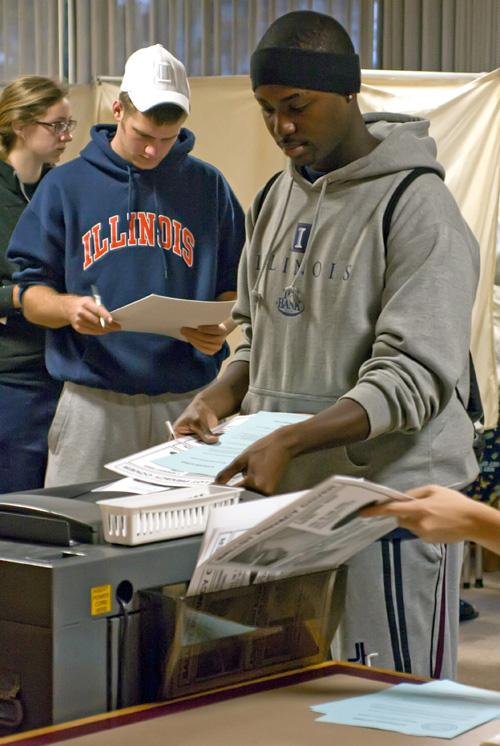Youth voter turnout: a noticeable increase?
Brendon Tero, sophomore in LAS, turns in his completed ballot at the Snyder Residence Hall polling place in Champaign, Ill., early Nov. 4. Erica Magda
Nov 12, 2008
Last updated on May 13, 2016 at 05:04 p.m.
Although Green Street filled with University students rejoicing Barack Obama’s win on Nov. 4, experts are unsure whether students displayed that same enthusiasm at the polls during the day.
Obama supporters like Dustin Choi, freshman in LAS, did not necessarily cast ballots.
“I didn’t vote because I really don’t think I’m that informed politically, plus I felt that Obama would win Illinois anyways,” said Choi.
Nationally, the Center for Information and Research on Civic Learning and Engagement, or CIRCLE, reported that voter turnout between the ages of 18 and 29 rose by 2.2 million compared with the 2004 presidential election, a 60 percent overall increase. The turnout, if calculated correctly, would prove to be the second-highest youth turnout since 1972.
Get The Daily Illini in your inbox!
Essentially, this means that 18 percent of everyone who voted on Election Day was between the ages of 18 and 29.
However, experts are debating whether local voting was consistent with the national trend.
Lloyd Winston, a Champaign County election judge for seven years, said this year’s polls were the busiest that he had ever seen.
“It is great to see the enthusiasm of students,” Winston said. “They should be commended for voting.”
But Brian Gaines, professor of government and public affairs at the University, said many theorists have estimated that all voter age groups, not just the youth, had increased participation in this election. If that’s the case, the increase in voter turnout for youth is in line with trends and doesn’t necessarily mean that the overall percentage of youth voters has increased dramatically.
Gaines said the overall increase in voter turnout could be credited to concerns about national issues.
“Obama spent more money on campaigning, and it worked,” Gaines said. “But people were also very unhappy with the Bush administration, and generally, voters tend to support the Democratic candidate when times are rough for the economy.”
While it is debatable whether youth voter participation in fact increased in the election, University and Champaign County voter statistics most likely won’t be released until the beginning of the new year. Another issue of great concern to many political science theorists is voters’ knowledge of the ballot. Voters in Illinois, especially, were caught off guard by the addition of the constitutional convention provision to the ballot.
“Information is easier to access because of the existence of the Internet, yet people still tend not to vote and/or research all the way down the ballot,” Gaines continued. “Many left the constitutional convention blank because they didn’t know about it.”
Some University students agreed after their experience with voting.
“I voted with a knowledge of the national and more prevalent issues, but I did little research into the local candidates and the constitutional convention,” said Janese Nolan, sophomore in LAS.






